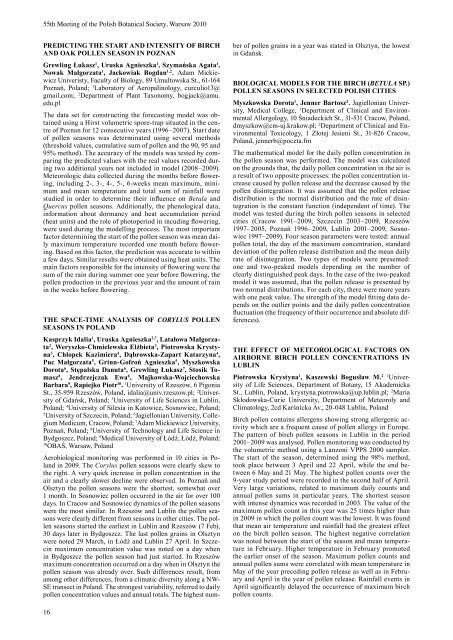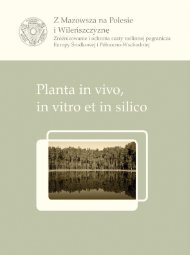acta societatis botanicorum poloniae - LV Zjazd Polskiego ...
acta societatis botanicorum poloniae - LV Zjazd Polskiego ...
acta societatis botanicorum poloniae - LV Zjazd Polskiego ...
Create successful ePaper yourself
Turn your PDF publications into a flip-book with our unique Google optimized e-Paper software.
55th Meeting of the Polish Botanical Society, Warsaw 2010<br />
PrEdICTING THE STArT ANd INTENSITY OF BIrCH<br />
ANd OAK POLLEN SEASON IN POZNAN<br />
Grewling Łukasz1 , Uruska Agnieszka1 , Szymańska Agata1 ,<br />
Nowak Małgorzata1 , Jackowiak Bogdan1,2 . Adam Mickiewicz<br />
Univeristy, Faculty of Biology, 89 Umultowska St., 61-164<br />
Poznań, Poland; 1Laboratory of Aeropalinology, curculio13@<br />
gmail.com; 2Department of Plant Taxonomy, bogjack@amu.<br />
edu.pl<br />
The data set for constructing the forecasting model was obtained<br />
using a Hirst volumetric spore-trap situated in the centre<br />
of Poznan for 12 consecutive years (1996– 2007). Start date<br />
of pollen seasons was determinated using several methods<br />
(threshold values, cumulative sum of pollen and the 90, 95 and<br />
95% method). The accuracy of the models was tested by comparing<br />
the predicted values with the real values recorded during<br />
two additional years not included in model (2008– 2009).<br />
Meteorologic data collected during the months before flowering,<br />
including 2-, 3-, 4-, 5-, 6-weeks mean maximum, minimum<br />
and mean temperature and total sum of rainfall were<br />
studied in order to determine their influence on Betula and<br />
Quercus pollen seasons. Additionally, the phenological data,<br />
information about dormancy and heat accumulation period<br />
(heat units) and the role of photoperiod in incuding flowering,<br />
were used during the modelling process. The most important<br />
factor determining the start of the pollen season was mean daily<br />
maximum temperature recorded one month before flowering.<br />
Based on this factor, the prediction was accurate to within<br />
a few days. Similar results were obtained using heat units. The<br />
main factors responsible for the intensity of flowering were the<br />
sum of the rain during summer one year before flowering, the<br />
pollen production in the previous year and the amount of rain<br />
in the weeks before flowering.<br />
THE SPACE-TIME ANALYSIS OF corylus POLLEN<br />
SEASONS IN POLANd<br />
Kasprzyk Idalia 1 , Uruska Agnieszka 2,7 , Latałowa Małgorzata<br />
2 , Weryszko-Chmielewska Elżbieta 3 , Piotrowska Krystyna<br />
3 , Chłopek Kazimiera 4 , Dąbrowska-Zapart Katarzyna 4 ,<br />
Puc Małgorzata 5 , Grinn-Gofroń Agnieszka 5 , Myszkowska<br />
dorota 6 , Stępalska Danuta 6 , Grewling Łukasz 7 , Stosik Tomasz<br />
8 , Jendrzejczak Ewa 8 , Majkowska-Wojciechowska<br />
Barbara 9 , rapiejko Piotr 10 . 1 University of Rzeszów, 6 Pigonia<br />
St., 35-959 Rzeszów, Poland, idalia@univ.rzeszow.pl; 2 University<br />
of Gdańsk, Poland; 3 University of Life Sciences in Lublin,<br />
Poland; 4 University of Silesia in Katowice, Sosnowiec, Poland;<br />
5 University of Szczecin, Poland; 6 Jagiellonian University, Collegium<br />
Medicum, Cracow, Poland; 7 Adam Mickiewicz University,<br />
Poznań, Poland; 8 University of Technology and Life Science in<br />
Bydgoszcz, Poland; 9 Medical University of Łódź, Łódź, Poland;<br />
10 OBAŚ, Warsaw, Poland<br />
Aerobiological monitoring was performed in 10 cities in Poland<br />
in 2009. The Corylus pollen seasons were clearly skew to<br />
the right. A very quick increase in pollen concentration in the<br />
air and a clearly slower decline were observed. In Poznań and<br />
Olsztyn the pollen seasons were the shortest, somewhat over<br />
1 month. In Sosnowiec pollen occurred in the air for over 100<br />
days. In Cracow and Sosnowiec dynamics of the pollen seasons<br />
were the most similar. In Rzeszów and Lublin the pollen seasons<br />
were clearly different from seasons in other cities. The pollen<br />
seasons started the earliest in Lublin and Rzeszów (7 Feb),<br />
30 days later in Bydgoszcz. The last pollen grains in Olsztyn<br />
were noted 29 March, in Łódź and Lublin 27 April. In Szczecin<br />
maximum concentration value was noted on a day when<br />
in Bydgoszcz the pollen season had just started. In Rzeszów<br />
maximum concentration occurred on a day when in Olsztyn the<br />
pollen season was already over. Such differences result, from<br />
among other differences, from a climatic diversity along a NW-<br />
SE transect in Poland. The strongest variability, referred to daily<br />
pollen concentration values and annual totals. The highest num-<br />
16<br />
ber of pollen grains in a year was stated in Olsztyn, the lowest<br />
in Gdańsk.<br />
BIOLOGICAL MOdELS FOr THE BIrCH (betulA SP.)<br />
POLLEN SEASONS IN SELECTEd POLISH CITIES<br />
Myszkowska dorota1 , Jenner Bartosz2 . Jagiellonian University,<br />
Medical College, 1Department of Clinical and Environmental<br />
Allergology, 10 Śniadeckich St., 31-531 Cracow, Poland,<br />
dmyszkow@cm-uj.krakow.pl; 2Department of Clinical and Environmental<br />
Toxicology, 1 Złotej Jesieni St., 31-826 Cracow,<br />
Poland, jennerb@poczta.fm<br />
The mathematical model for the daily pollen concentration in<br />
the pollen season was performed. The model was calculated<br />
on the grounds that, the daily pollen concentration in the air is<br />
a result of two opposite processes: the pollen concentration increase<br />
caused by pollen release and the decrease caused by the<br />
pollen disintegration. It was assumed that the pollen release<br />
distribution is the normal distribution and the rate of disintegration<br />
is the constant function (independent of time). The<br />
model was tested during the birch pollen seasons in selected<br />
cities (Cracow 1991– 2009, Szczecin 2003– 2009, Rzeszów<br />
1997– 2005, Poznań 1996– 2009, Lublin 2001– 2009, Sosnowiec<br />
1997– 2009). Four season parameters were tested: annual<br />
pollen total, the day of the maximum concentration, standard<br />
deviation of the pollen release distribution and the mean daily<br />
rate of disintegration. Two types of models were presented:<br />
one and two-peaked models depending on the number of<br />
clearly distinguished peak days. In the case of the two-peaked<br />
model it was assumed, that the pollen release is presented by<br />
two normal distributions. For each city, there were more years<br />
with one peak value. The strength of the model fitting data depends<br />
on the outlier points and the daily pollen concentration<br />
fluctuation (the frequency of their occurrence and absolute differences).<br />
THE EFFECT OF METEOrOLOGICAL FACTOrS ON<br />
AIrBOrNE BIrCH POLLEN CONCENTrATIONS IN<br />
LUBLIN<br />
Piotrowska Krystyna 1 , Kaszewski Bogusław M. 2 1 University<br />
of Life Sciences, Department of Botany, 15 Akademicka<br />
St., Lublin, Poland, krystyna.piotrowska@up.lublin.pl; 2 Maria<br />
Skłodowska -Curie University, Department of Meteoroly and<br />
Climatology, 2cd Karśnicka Av., 20-048 Lublin, Poland<br />
Birch pollen contains allergens showing strong allergenic activity<br />
which are a frequent cause of pollen allergy in Europe.<br />
The pattern of birch pollen seasons in Lublin in the period<br />
2001– 2009 was analysed. Pollen monitoring was conducted by<br />
the volumetric method using a Lanzoni VPPS 2000 sampler.<br />
The start of the season, determined using the 98% method,<br />
took place between 3 April and 22 April, while the end between<br />
6 May and 21 May. The highest pollen counts over the<br />
9-year study period were recorded in the second half of April.<br />
Very large variations, related to maximum daily counts and<br />
annual pollen sums in particular years. The shortest season<br />
with intense dynamics was recorded in 2003. The value of the<br />
maximum pollen count in this year was 25 times higher than<br />
in 2009 in which the pollen count was the lowest. It was found<br />
that mean air temperature and rainfall had the greatest effect<br />
on the birch pollen season. The highest negative correlation<br />
was noted between the start of the season and mean temperature<br />
in February. Higher temperature in February promoted<br />
the earlier onset of the season. Maximum pollen counts and<br />
annual pollen sums were correlated with mean temperature in<br />
May of the year preceding pollen release as well as in February<br />
and April in the year of pollen release. Rainfall events in<br />
April significantly delayed the occurrence of maximum birch<br />
pollen counts.



